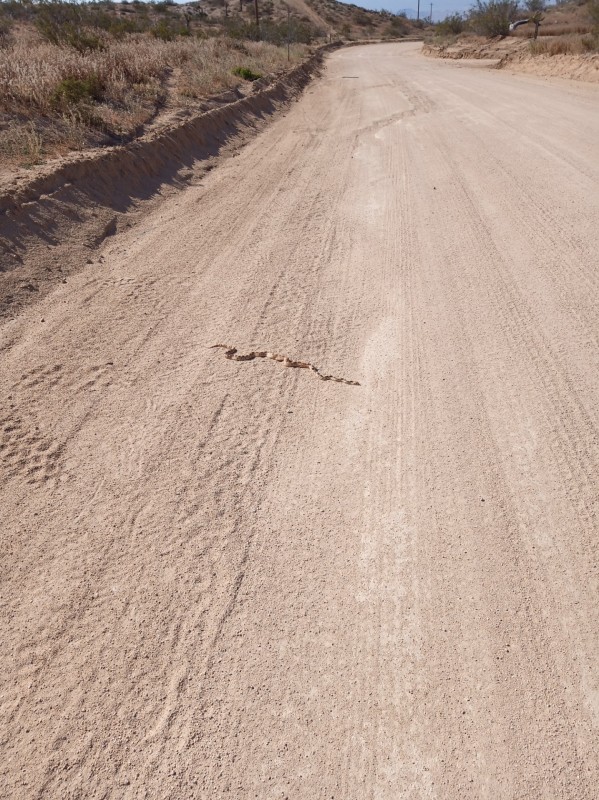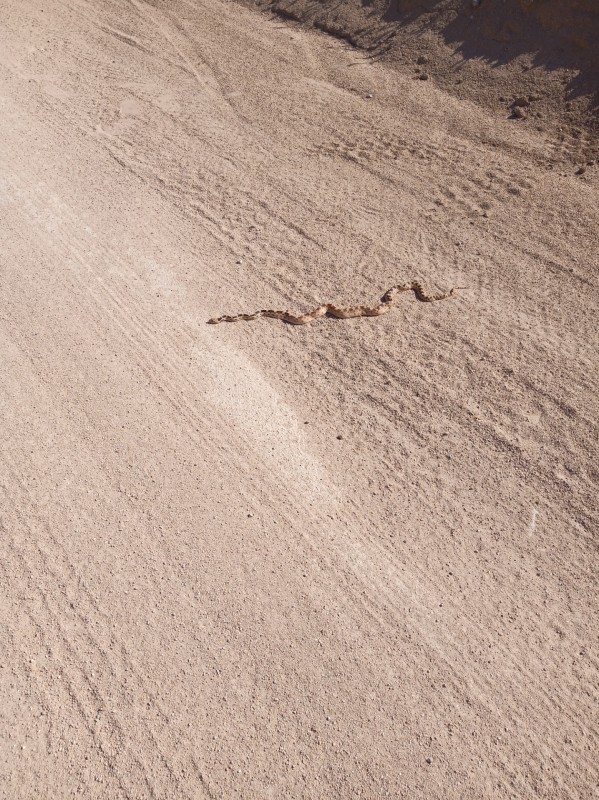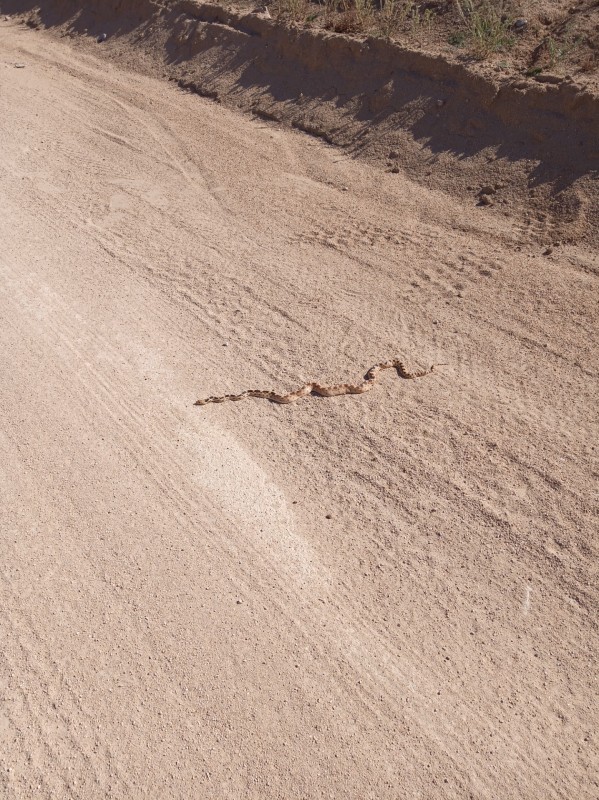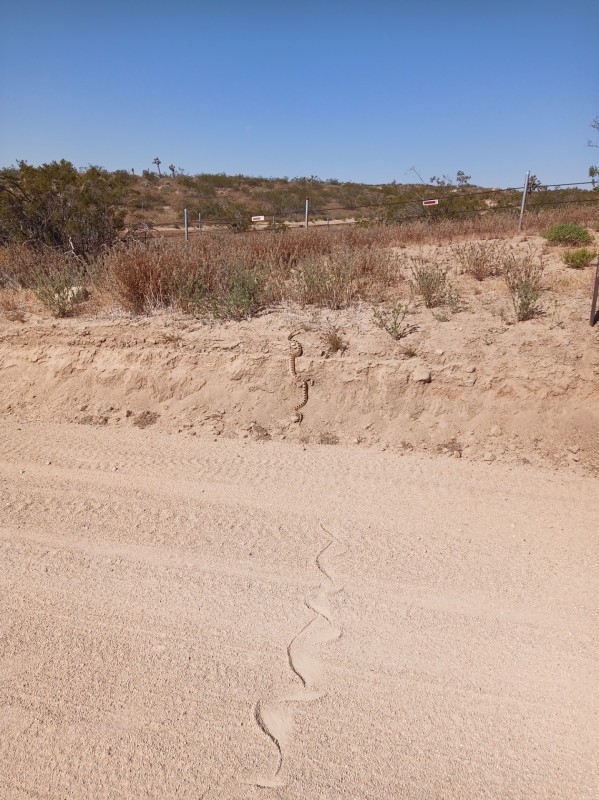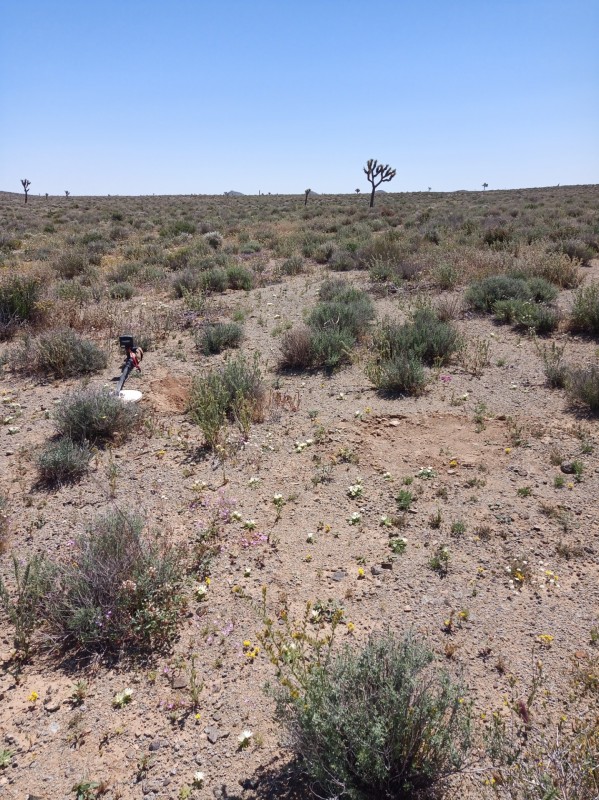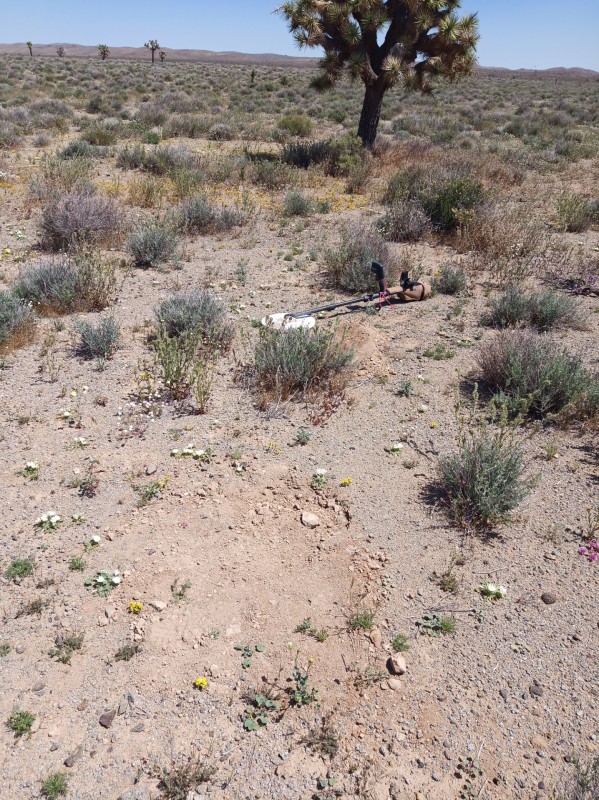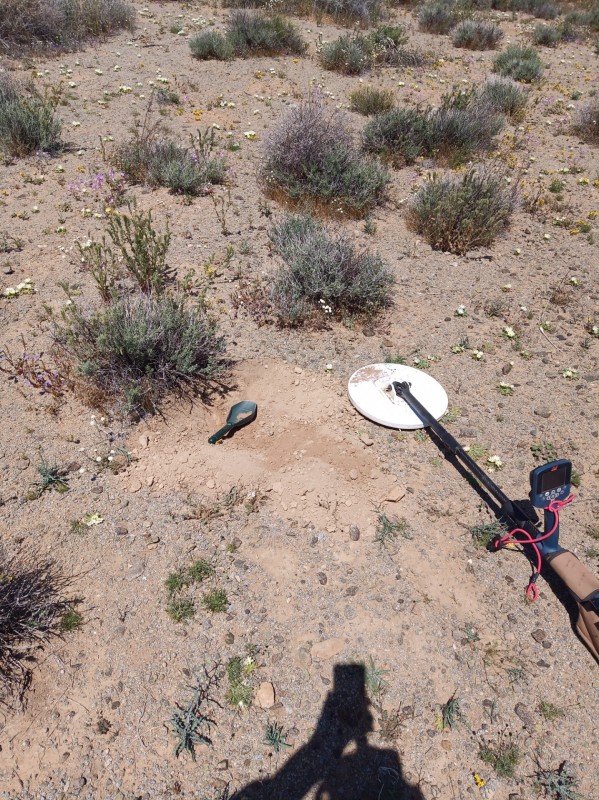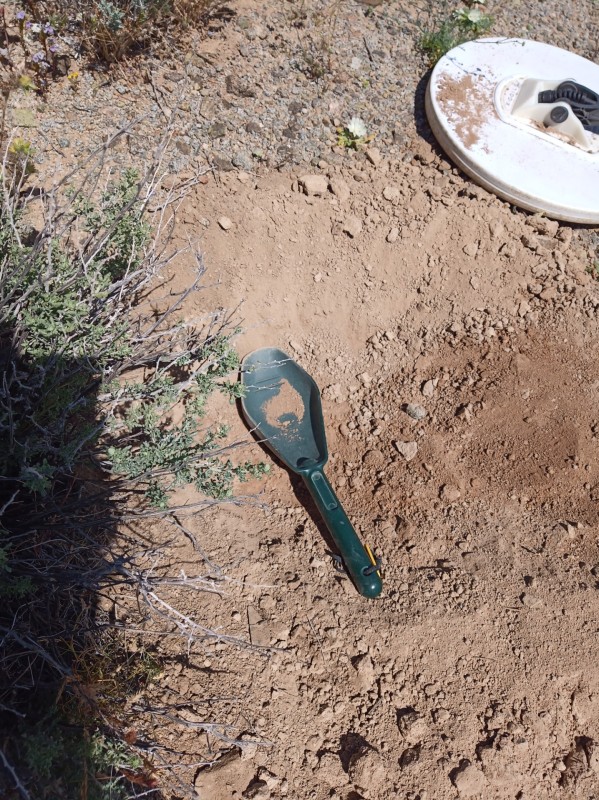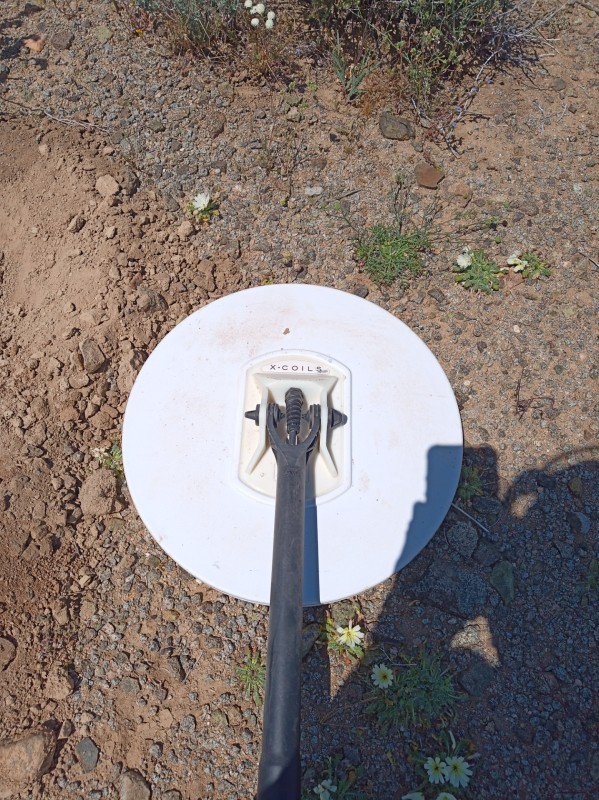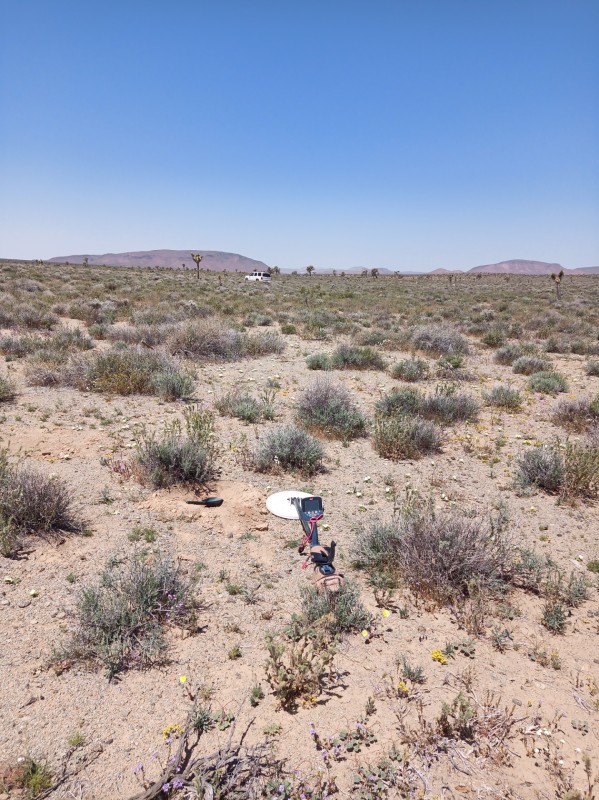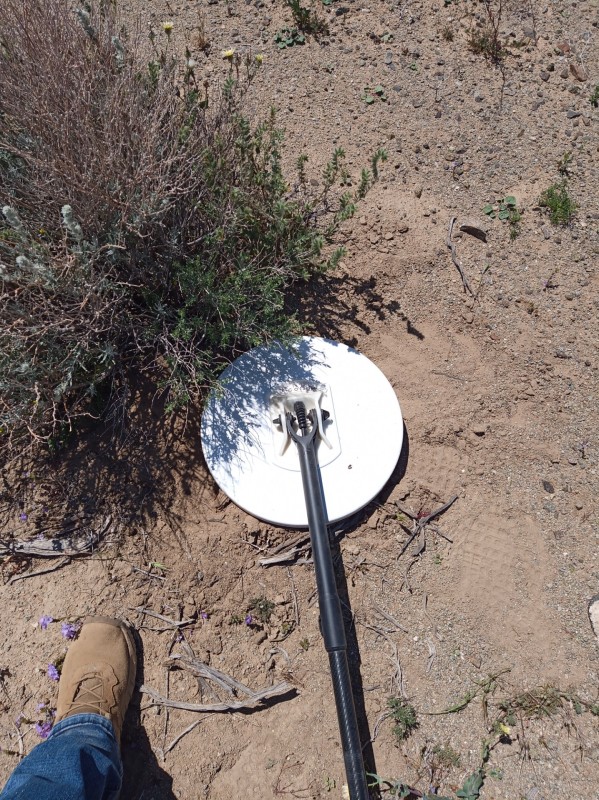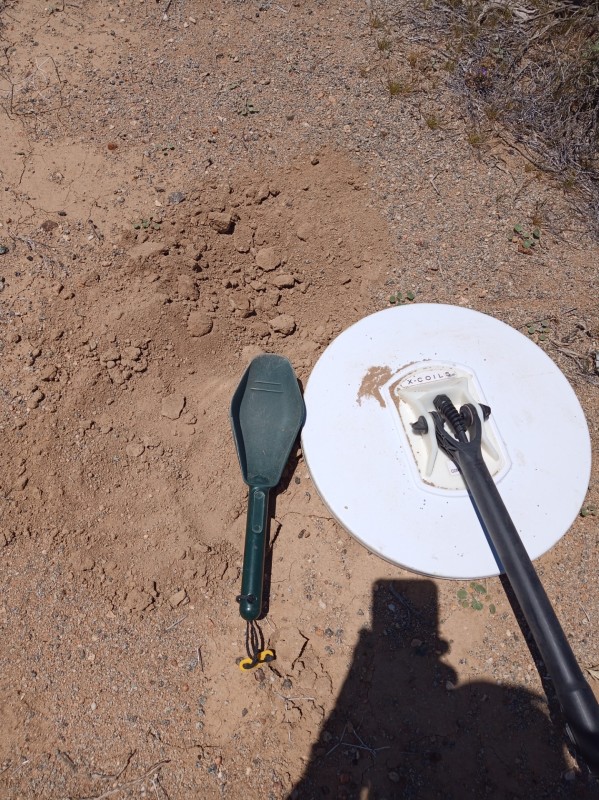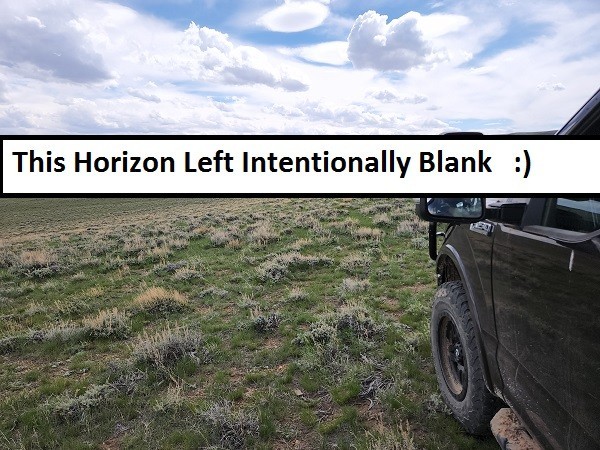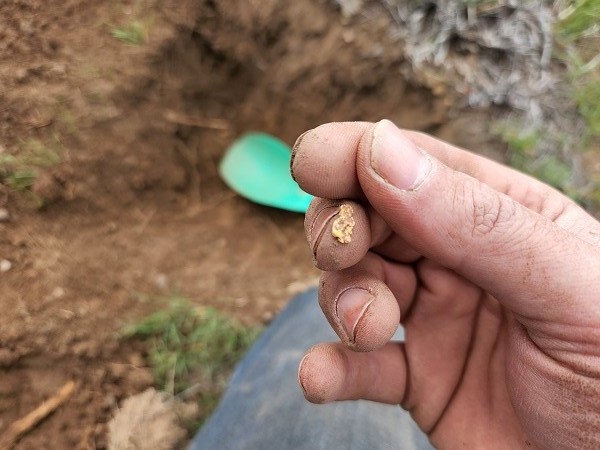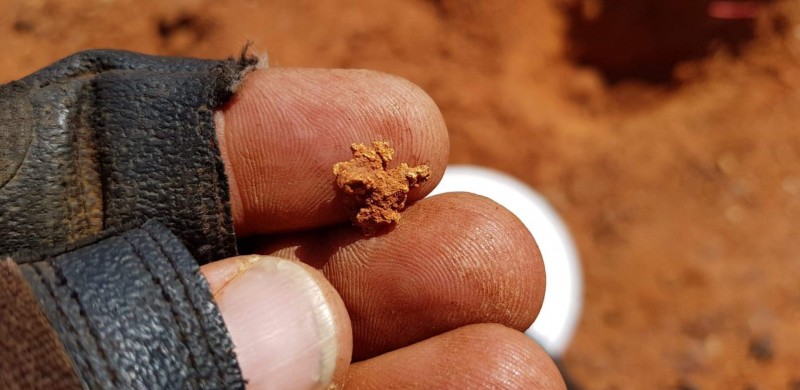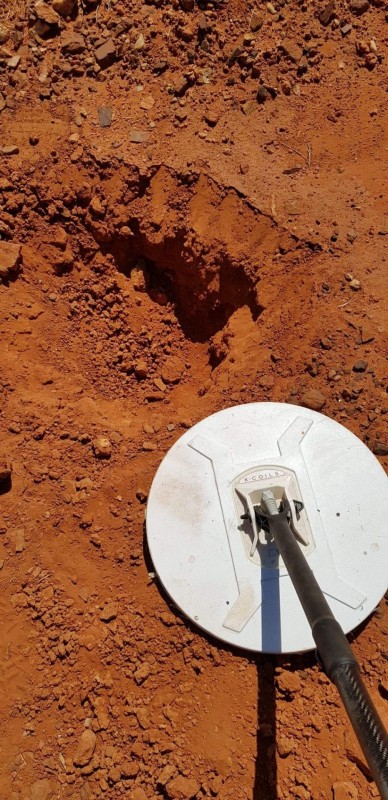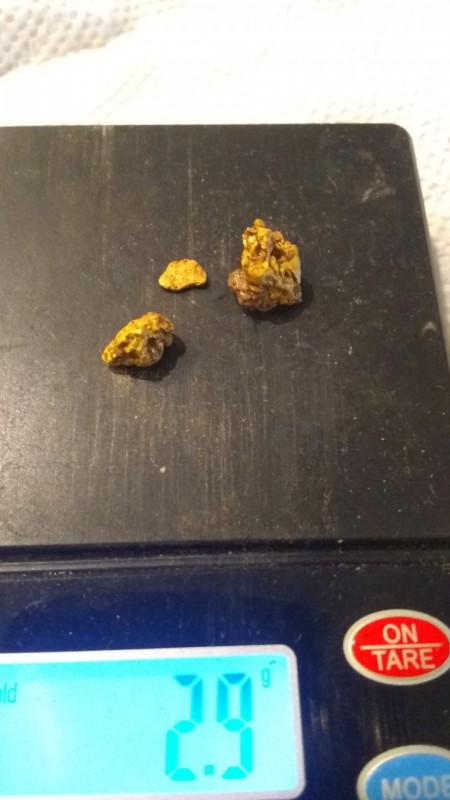Search the Community
Showing results for 'GPZ 7000 ferrite'.
-
Doc, was kind enough to send me his new DALAS (Detector Air Lift System) and it arrived Friday right at Mother’s Day Weekend. Now, I’m sure my Wife Robin is like many other Wives on the Forum and tends to think the entire Weekend is about being Pampered. I didn’t open Doc’s Parcel till mid day Saturday…after feeling the sting of Mother’s Day Weekend kickoff in “The Biggest Little City In The World.” Yes, the Granite Countertop had a burn mark under the box! I ran out to my 1/3 rd of the garage digging thru all my Backpacks and Military gear trying to find a stand alone Harness System. Not finding what I wanted I settled back to my Minelab Harness that I have my Hip Stick attached to for ever. All this time, Robin was thinking I was cleaning up my part of the 3 Car Garage. End result, it did look better! 😂 Now following Doc’s Video and written Supplemental Instructions, it was time to hit up Robin to mark the Struts and Rod to drill the screws in for the Back Paddle. I ran out to the garage to fit with my Minelab Harness and attach my GPZ 7000 to it. I called Robin out from behind her Mother’s Day Weekend Book reading for the final upper Strut marking to set the screws. She did comment about my straightening up my workbench. Adjusted to my liking, I set the screws. As you can see, my Minelab Harness is well equipped with my GPZ 7000 Ferrite Ring, Wireless holder, TP Holder w/Matches and one extra Water Bottle and noise maker to let the many BigFoots and Aliens know I’m happy to be out in the middle of no-where! With both my Hip Stick and the new DALAS set up side by side, it was easy to switch back and forth to test the end result. It’s was nearly like Night and Day with my test swinging in the backyard with the DALAS winning hands down. But, this wasn’t Real World testing! I loaded up my truck and Monday headed out to Rye Patch. The week prior, I was out swinging with my Old Buddy Rudy patch hunting. I was swinging my 6000 and it was struggling with the damp ground and windy conditions and Rudy, decided to use his 7000 because of the conditions the 6000 was struggling with. He dug up a nice one! Arrived, unloaded and met up with another Buddy Art from Pennsylvania. Art, has become quite the prospector over the years with several nuggets to show me as we caught up. He too, is Ex-Military and armed with a GPX 6000. We loaded up in my little Red Buggy and set off into the Desert. As you can see, I’ve been well trained during my Military Career to bring everything you need to win the battle. There is one item, that will not be on my Harness anymore and that is the Hip Stick! Yes, I did swing the 7000 for a few hours. The 7000, is a much heavier detector than the 6000, as you may know. with the DALAS and the use of Doc’s Swing Arm i didn’t have to have my arm in the 7000’s Arm Cuff, just on the handle and later I could just put a couple fingers on the back end of the Arm Cuff to rise and lower the 7000 to match the terrain and use the swing arm to swing the 7000. Wow! The 7000 Beast was under control. The DALAS does pull the back of your pants out (not down) and I had to have my Minelab Harness above the Back Paddle of the DALAS for full benefit. The added feature on a hot windy day of detecting in the High Plains is just add weight to top rod for cooling effect 😂. Now, which detector is my main detector, the GPX 6000. The GPZ 7000, is my backup detector and is mainly used for deep nugget patches or last swinging of new patches, nowadays. With the current conditions on some of the ground in Northern Nevada having it coupled to the DALAS was a welcome to a smooth threshold. Until the next Hunt, LuckyLundy
-
Nugget Finder Z-search 3 Different Version Coils?
Nedkelly replied to Gerry in Idaho's topic in Detector Prospector Forum
I can't thank you enough JP , recently bought a 18 month old 7000 and been playing around with it. Next time I go out I'll be using your settings, ferrite balance technique and try a manual emi noise cancel. 👍- 37 replies
-
- minelab gpx
- minelab gpz 7000
-
(and 1 more)
Tagged with:
-
I hold the 7000 in air with left elbow balanced on the top of the arm rest strap, holding the handle with my left hand with the coil held flat in air relative to the ground (folded flat against the shaft), then with my right hand I quickly side to side wave the ferrite on a stick over one receive point UNDER the coil (both receives are fine too) to excite the X balance (Ferrite calibration) with the unit in Semi-Auto and Quick-Trak button held in. (I usually wave a bit before triggering QT to listen to how much ferrite signal there is first). Sometimes it pays to release QT and trigger it again a few times to excite the tracker and force the process. When you use this in air method the G balance will be out as it’s balancing to nothing (X and G are both balanced out at the same time when QT is triggered) so once QT is released I bring the coil to the ground and gently pump up and down and will even sweep side to side then up and down to allow the Semi-Auto GB to get the ground balance (G balance) back to accurate. Sometimes if the GB is way out the tracker will lock because of the loud ground signal (called pausing effect, you need this to prevent tracking out a good target at depth), so I’ll just place the coil on the ground and leave it motionless for a few seconds to allow the tracker to unlock, then resume pumping, repeating this till you hear the tracker kick back in and balance out the ground signal. At no stage after this process do I EVER trigger Quick-Trak unless the Ferrite is present. If you want to be particular and OCD like me you can lift the coil in air again after the ground balance is correct and check the ferrite in air without pressing QT to double confirm there is no Ferrite signal. BTW it is OK to have a small amount of Ferrite signal as the ground signal will always be stronger than a tiny bit of residual Ferrite signal. The timings that require the most attention are High Yield Difficult and High Yield Normal especially if you have the Gain up a fair way. The key thing is to get rid of any loud signal coming off the ferrite, if there are loud signals the G balance will try to compensate for them and your ground balance will be inaccurate. I don’t ever use AUTO because if there are conductive signals present (all gold fields have them) or saturation signals (Australia usually has both together, especially after rain events) then the tracker can’t tell them from X signals and will come up with bad numbers, the poor old G tracker will take the brunt of the assault and try and compensate ending up with a lot of false signals and an unhappy user. When using Semi-Auto, the ferrite calibration is linked to the detectors electronics and more particularly the temperature of the electronics. So in winter for instance the detector will be at ambient temperature at the start of the day, from start up it will be dead cold gradually warming to over 45 degrees internally, so the calibration at the start of the session will slowly move away from optimum to operating temperature but the Ferrite balance is locked in Semi-Auto mode once QT is released, so I recommend to check the ferrite calibration after an hour. In warmer weather it hardly changes (minimums of say 18 degrees C to over 40’s), but I check it anyway because I’m OCD as heck about it. 😂 The key is to have no signal off the ferrite. X balance is tied in with the temperature of the electronics, the X balance calibration is locked if Semi-Auto is used. If X is correct (no signal off the Ferrite relative to the electronics temp) then it doesn’t matter how bad the ground is for X no X signal will be heard unless it is extreme like a high X hot rock (magnetic hot rock). Any X signal that is seen by the machine (incorrect X balance for example) can mask or hide a good target signal at depth. X signals get blended in with general detector behaviour and are very hard to isolate, it’s just an extra layer of noise that does not need to be there. The Ferrite represents X, the one Minelab supply is a specific type, so not just any ferrite works. The reason I use the above in-air method and not just putting the ferrite on the ground is because I work in mostly high X and more particularly high Saturation environments. If the ground has high saturation (where the Tx is affected by highly magnetic surface particles) the saturation signal can be boosted/magnified up through the centre of the ferrite more than double the distance from the ground where the saturation would normally be heard, this can trick the X tracker to some extent but also give the impression the X tracker isn’t working in the Semi-Auto mode. In such cases no amount of ferrite balancing will get rid of the signal as it is a magnified saturation signal you are hearing not the Ferrite, this magnified saturation signal prevents you from getting the coil right onto the ferrite for best calibration practices. Such scenarios can be very confusing and damage confidence. So for peace of mind I just do it in air to get the best calibration possible. NOTE: You can place the ferrite on a large rock away from saturation signals if you have no stick or left the stick at the car. The key here is being informed, knowledge is power. Once you know what something is, then you’re empowered to do something about it or ignore it. That is the mantra of all my training sessions, informing and empowering. Hope this helps JP
- 37 replies
-
- minelab gpx
- minelab gpz 7000
-
(and 1 more)
Tagged with:
-
Hi Gerry, thanks for the kind words. I too was on the fence when it came to seemingly oversimplifying a detector but the sales and facts speak for themselves. The GM 1000 was an all time best seller for Minelab and still is selling well. The GPX 6000 is also extremely popular and gaining more and more popularity every day as the COVID and other release gremlin’s get ironed out and people learn to trust what it can do and appreciate the benefits. I don’t say these things lightly. The 6000 does not require huge experience to be used effectively, it is simple enough that a pretty inexperienced user can go find some gold even in the harshest ground types. Too many controls can bamboozle even an experienced operator because so much of metal detecting has to do with your mind. You introduce too many variables and it kills confidence, that your settings are wrong or someone is not telling you the “secret” combination. I used the proto Axiom in some pretty bad ground and I tried all the various settings combinations to try and get some advantage out of the “features” and I found myself just coming back to the same settings over and over again. The biggest advantage I found in the short time I used them was getting the threshold pitch and threshold correct on edge of detection gold. Probably the most confusing thing about the 6000 is pairing the bluetooth and accidentally pressing the soils button and then trying to use Normal timings in Hot ground. Those two are the biggest newby mistakes. I agree about the shaft being round but it honestly doesn’t worry me, I have my lower rod super tight and never undo it day to day and only ever shorten the mid shaft when I pack up and head to another location. Getting back on topic, using the GPZ 7000 and Nugget Finder Zsearch 12 combo I rarely change my settings from one day to the next (a little like the 6000). I actually change my sensitivity all the time on the 6000 dependent on ground whereas the 7000 is pretty much set and forget. Threshold 27 Theshold Pitch 40 Sensitivity 12 Audio Smoothing OFF Ground Balance Semi-Auto Ground Smoothing OFF Timings High Yield Ground Type Difficult I go out day after day after day using those exact same settings, the only thing I do from one session to another is check for EMI and do a manual Noise Cancel if necessary, then perform a Ferrite Balance under the coil IN-AIR in Semi Auto mode using Quick-Trak (I have my ferrite taped on a stick) and then pump the coil over the ground with no Quick-Trak then get detecting. That’s how I train people as well. Obviously in soils that can handle Normal you can go from one to the other, but from a newbie POV it is better to stick to Difficult till they learn the basics and develop some muscle memory (coil control, eye, hand, hearing symmetry). JP
- 37 replies
-
- minelab gpx
- minelab gpz 7000
-
(and 1 more)
Tagged with:
-
Regarding the 7000; try the difficult setting, high yield, and sensitivity as high as it will go while maintaining a smooth threshold. Try auto tune a couple of times one right after another. Toss the ferrite ring with your eyes closed and see if you can find it next spring. Going slow is the fastest way to find gold. The 4000 with a Joey coil is a highly classified secret weapon so don't tell to many about your successes with it. If you reply to Jasong he will have some good suggestions. Would you treat us to some photos of your detecting grounds?
-
Simon said 'Go Back' and I did for perhaps the last time in a long while to this spot. I cranked it up to 20 and tested it in various combinations of auto, semi-auto, manual, ground smoothing, hy, general, salt, etc. I used the ferrite ring and not also. The first place I went was back to where I found the largest nugget on my first trip. I worked my way slowly there without finding anything. Then I took a circle around the spot where I found the nugget and I got a nice mellow 'dig me' signal. I went back and got my phone to take pictures. This was the area. If you notice there is the fresh hole that I dug near the detector and just to the right of it less than 10 feet away was the hole I dug for the other nugget. My phone had lost power and I couldn't take a picture then. Here is a different angle with the previous hole at the bottom. Now I'm on the new hole. Notice how I bungee and support my 7000 from the handle with a hip stick. I do the same with my 3030/17 on the beach. I don't understand why this isn't the support spot for all 'heavy' detectors! There is the nugget from this hole. A bit flat but I think it was sitting on edge. It looks bigger than its .25g weight. Looking back where I parked. It was not much of a distance. Later I found a piece of trash under a bush. I took this picture to show that you don't have to be directly over a target to hear it with a CC. I heard the bullet casing and dragged it from under the bush with my foot. Tiny, tiny screamer that was getting blown away by the wind. That was it as far as nuggets went. This was the picture of the snake I saw in the road on the way in. I'm going to post it separately to help us be aware of them.
-
You could always pass it under the GPZ 7000. It might ferrite balance nicely 🤔 😂
-
Can the GPX 6000 balance both 'G' and 'X' the same as GPZ 7000 does? The GPX 6000 does not track the Ferrite component of the ground. GeoSense-PI uses other techniques to remove the 'X' response that is invisible to the operator. You do not need a yellow ferrite to ground balance the GPX 6000. From the Minelab website.
-
Heard, but I still don't think the ML ring is powdered iron. At least, not if that's what the other ring is, which it has to be because it rusts and is much more dense and highly magnetic. The ML ring is painted yellow, not black. The black is the ferrite itself after I sanded the yellow paint off. Density, magnetism, conductivity all indicate it's ferrite when compared to the other ring. Looks, walks, quacks like a duck... But I'll try to find those rings again and throw them on the XRF just to see for certain. I'll post back here if I can find them, all my unused stuff is packed into boxes right since I'm moving so I'm going to have to do some digging. It'd be good to know, whatever the case may be. What I can say for certain is this: the ML ring balances out on the 7000. The other ring does not, it sounds like an iron target. So they are definitely two different materials and one probably isn't doing the job it was intended to do.
-
ML themselves seem confused on the issue then. Because if you grind the paint off the official Minelab ring, you will see it's actually black ceramic ferrite under the paint, not metallic powdered iron as they apparantly recommend. Unless the powdered iron look black also? In which case, the Doc's ring was some kind of pure iron then, it was shiny and metallic and extremely magnetic. The two types of rings respond very differently on the 7000, the metallic iron rings will not balance out and sound like more like an iron target than ground noise. I found the thread where I showed the difference here. You can see the black powder on my hand from the official Minelab ring too.
-
https://www.minelab.com/__files/f/254884/KBA_26-1 GPZ 7000 Tips for Better Ground Balance.pdf "In order to artificially add extra data for improved ground balance calibration, you can use a dust iron toroid, commonly referred to as an electronics 'ferrite'. The electronics industry uses these magnetic cores extensively in computers, televisions, and mobile phones. Ground balancing using a ferrite means that less soil needs to be covered during the initial ground balance period because the ferrite artificially adds very useful data to assist achieving an accurate ground balance." Emphasis added. There is nothing in this document that implies that using the ferrite is mandatory, but simply that it can help aid, or speed up, the ground balance process. Obviously detectors need to ground balance, but not one other Minelab detector needs a ferrite ring, so this is an issue regarding the GPZ, not detectors in general. As it was explained to me the need for a ferrite balance was for soils that lack enough naturally occurring ferrite. In that situation, the GPZ would not balance properly, or take longer than normal to get balanced. For soils with sufficient naturally occurring ferrite, no additional ferrite in the form of the ring is needed. Apparently Oz soils tend to lack this component, but in the U.S. naturally occurring ferrite is abundant. This is what I was told directly by Minelab, and if incorrect, then you'll have to argue with them, not me. I will say that in general, I rebel at being told what my personal experiences are, or are not, and most especially, how to react to things, how seriously to take them or not, etc. That all said, I'll repeat what I said earlier: "Can't swear it ever made a difference in my use in the U.S., yet I always used it as part of my tune up routine. Maybe it helped and I simply don't know it. Long story short, it can't hurt, might help, why not? You want to own the most expensive nugget hunter ever sold, best performance possible.... but that one little thing is just too much?"
-
PI isn’t affected the same but a lot of saturation signal comes from high X ground, this is especially noticeable with the Flat wound coils, they see a LOT of X. Hence why I tell people to not scrub the coil in highly mineralised soils/gravels etc. X signal is no joke on the 7000 so I’m surprised by all the head in the sand humour surrounding it’s use on here 😁. Yeah I get the humour, Octopus dance, Ferrit, ritualised activities around the fragile yellow round thing etc,🤣 but in reality it is an important aspect to ZVT and should be taken very seriously.🤗 Just because you don’t understand its use or can’t see the benefits doesn’t mean you should not use it and instead become part of the Anti-Ferriters,🙃 there is another very hot topic raging around the world as we speak that follows a similar vein. Just because a LOT of people agree with you does not make it correct. 🤭 Use it, don’t use, get Ferrited or be a vocal Anti-Ferriter that’s your choice,😁 hey better yet buy a 6000 or an Axiom then you don’t have to do the Octopus dance of zero comprehension!!😁 I’m amazed after all this time that there are still people out there who refuse to inoculate with the Ferrite,😄 I honestly thought that discussion had been put to bed. Just like that hot world topic there are plenty of people who aren’t Ferrited who do perfectly fine without all the hoopla of the ritual of the “Yellow Lord of the Rings” 🤣 so at the end of the day its your choice, just please don’t deride what you don’t understand.😋 JP
-
What coil do you have on your machine? In some ground where there is a bit of saturation signal the round ferrite will channel that signal up itself magnifying it, this can sound like the Ferrite isn’t being balanced out but in fact it’s saturation signal, you cannot ground balance out saturation. Best bet is to place the ferrite on top of a big rock (4 inches or so high) or put your ferrite on a stick and hold the coil away from the ground waving the ferrite under the coil over the windings till the noise goes (with QT depressed of course), then bring the coil to the ground and slowly pump the coil till the Semi-Auto GB balances out the ground signal. (The GB for the ground will be out because when the coil is held in air you are balancing to nothing as you calibrate to the ferrite). If there is only a small signal off the ferrite don’t worry about it, the key is to not have a LOUD target like signal on the Ferrite. General ground noise will cover any mild signals especially when using Normal. The Most sensitive mode on the 7000 to the ferrite is High Yield Normal.
-
It is highly recommend you use the ferrite ring to calibrate your GPZ7000 for X signals. X is seen by the detector if the calibration is incorrect. X calibration is determined by the temperature of the electronics, so as an example if you perform an X balance at the start of your session at a winter morning ambient temperature the control box will slowly warm up until the electronics reach operating temperature, as such the calibration once warm will be different to that attained at the start of the session. X calibration can also be affected by the use of Auto whereas Semi-Auto is a FIXED state for the Ferrite balance, Quick-Trak affects the ferrite calibration no matter which Ground Balance mode you are in, Auto, Semi-Auto or Manual. It is not recommend you used Quick-Trak without the Ferrite present. In low X areas (even quiet soils can have high X) the Auto mode will generally do a good job of keeping the X calibration accurate but this can change if there is a LOT of conductive signal as the algorithm CAN’T always tell the difference between Salt/conductive signals and Saturation signals (Saturation is not such a problem in the US). I recommend you use Semi-Auto mode and perform/check the X calibration for the given temperature at the start of a detecting session and again about an hour later once it’s warmed up. If there is a signal on the ferrite then your machine will make noise on any X the coil gets exposed to, the signal from X gets mixed in with general ground noise but will elevate overall detector ground signal behaviour potentially masking deep gold. Not all Ferrites are created equal so I’ve attached the recommendation section off the ML website on what specification off ferrite should be used. An incorrect ferrite with the wrong values can cause havoc. If you don’t feel the need for a Ferrite then I highly recommend you use Auto mode. It only takes seconds to wave over a ferrite at the start of a session in Semi-Auto mode, if there is a bit of signal off the ferrite then hold QT in till the signal goes away and your good to go. If your machine is making a signal on the Ferrite then it will make signals on any X in the ground which then blends in with ground noise, even VERY experienced GPZ users struggle to determine X signals from ground signals. https://www.minelab.com/__files/f/254884/KBA_26-1 GPZ 7000 Tips for Better Ground Balance.pdf
-
Hey Art, Here are my thoughts, at least here in Arizona. When the Minelab GPZ 7000 originally came out, with the first firmware update, there was no Ferrite ring included with the detector, nor was it available. It wasn't until a year or so later, the Ferrite ring was included in the detector and the firmware was updated (new purchases or available to download). For 2 years solid, I found some of my best gold with the GPZ 7000 and never used a Ferrite ring. I would just do the normal balance in the "Auto" mode and start hunting. I actually found in my opinion some of my smallest gold and largest with the original firmware and felt later one after the additional firmware updates I was finding smaller and not as deep. This might just by in my mind, but I remember finding smaller gold with the stock 14x13 back then. I have used the Ferrite ring over the years and do carry one with me for the most part, but haven't really seen a huge difference using it vs. not using it. Now when it comes to Ferrite rings, they say the color ID's the Ferrite ring. However, some have claimed Doc's don't do the same as the Minelab one and I haven't found any truth to this. I have even brought this to Doc's attention years ago, but I still have customers that claim the Minelab one works better than any aftermarket one. Just some thoughts on this. Rob
-
I don’t have my GPZ anymore, but one of my last discussion on it was about the ferrite ring. The first shipments didn’t have one it was a later add on I thought more for some X factor that was an issue in the heavily mineralized soils in Australia. The 7000 was at times pretty unstable depending on conditions and the rings were shipped everywhere. It became a ceremony starting up the GPZ you’d do your act of contrition throw down the ring for a donation to appease the Devine spirit of the holy patch and spend the day praying for gold. minelab later anointed us with an offering our first communion a spiritual update version XX and all was good in the kingdom of the fields, did we in the western kingdom need to continue the ceremony of the ring… or was it a habit that brought spiritual peace, for we had already reached salvation? out of curiosity having committed first the sin of breaking my ring and then an almost unforgivable act of forgetfulness the omission abandonment the ring never to be seen again. who among us, cast the first stone discarding the past traditions of our faith and ditched the ring and why, conversely for those finding comfort in the old traditions why, does it still bring you closer to the enlightenment we seek. seriously, here in the milder soils of the untied states, does it help or do we use it because minelab gave it to us and it might make a difference, after losing my second ring I guess I lost faith and moved on not noticing a difference in the obstacles of my journey.
-
So, I went on a little afternoon hunt in the Mojave Desert. I did not have much time but thought to check out a wash where I found gold before with the SDC. The ground conditions there are extremely mineralized and the wash is littered with hot rocks, mostly volcanic in nature. The 6000 did not work at all, even at the lowest sensitivity and in difficult (threshold on/off made no difference). The saturation signal was just way to high and virtually every other rock, even tiny ones, gave a target signal (both high/low or low/high responses). I hence decided to try the 7000 to see if detecting would be at all possible in these challenging ground conditions, by using the settings that the 7000 has to its disposal. My initial to go settings (HY/Normal/Gain 15/smoothing off/semi auto GB) miserably failed (as expected) with saturation/hot rock responses similar to that of the 6000. I then dialed down the settings and used HY/Difficult/Gain 9/smoothing low/auto GB/threshold volume 22, volume 6. These tamed-down conditions had a huge impact with the detector now running fairly smoothly with much reduced hot rock responses. The auto-GB/ferrite worked better (IMO) than the semi-auto GB/ferrite, something that I contribute to my believe that the auto-GB is better in adjusting to extremely hot rock littered grounds, as opposed to having a fixed X-lock. I checked after a while and I did not have a significant ferrite drift. I usually always run semi-auto but in this case the auto-GB performed slightly better and gave a more stable threshold. However, I am of course aware that semi-auto GB is generally the better choice for most cases to not have any X-drifts. Despite running the 7000 with these tamed-down conditions (or probably because of them!), I managed to pick up a clear target signal amongst all the hot rocks that turned out to be a 0.7 g picker. I was over the same spot with the 6000 before and heard absolutely nothing, due to all the saturation signals around me. To me, this is where the 7000 shines. You can either run it insanely hot (which I often do), or you can significantly alter the detector’s profile to adjust to various ground conditions, including the extreme conditions I have been in, and still find gold. This is something the 6000 clearly lacks and which is a significant advantage of the 7000. The 6000 is still my to-go detector, but if I did not have the 7000 this wash would have been nothing else than frustrating. This is a good example that more power isn’t always better and that the 7000 finds gold in all kind of different conditions, if settings are being adjusted accordingly. The last picture shows the incredible breath-taking scenery. Also, you can see that there is a lot of sand mixed in as well where detecting does not make any sense. In addition, there are also much milder patches of ground and the day before I found a similar weight nugget there with the 6000 run in auto+. This wider general area has produced very large nuggets (up to 156 oz). Oh well, perhaps next weekend. 😁 GC
-

Running The 15" Cc X Coil Over A 6000 Patch
jasong replied to jasong's topic in Minelab Metal Detectors
Hey Bill, I'm in some terrain that in many ways resembles that around Rye Patch. I would say as a whole it's less salty though, or more patchworked alkali anyways, with areas of more extreme salt and less extreme salt. Also, the ground is more mineralized with regards to the ferrite component here too. But similar conditions. I think the 6000 is a great detector for NNV, and also for Colorado. If I only wanted one detector to primarily work those two places, I'd personally choose the 6000 so I think you made a good trade. In fact, when I detect down in your part of Colorado later this year, I'll probably just take the 6000 with me. The steeps...too gnarly with the GPZ unless I have some very specific, small areas to concentrate on. But yeah, these concentrics are definitely deep in the places you can run them. Heavy salt is not particularly their forte though. But they are doing good with the ferrite mineralization (no worse than the stock coil anyways, maybe slightly better), and these things just absolutely slay the deeper ground and have literally produced deeper gold every single patch I've tried them on. For places like Arizona they are amazing. For people that have a stable full of good, deep, productive old patches, these things are literally like having a GPZ 8000 to me, a tool that is clearly more capable than anything else on the market right now. I'm actually pretty surprised there aren't more AZ detectorists using one, but that's just fine with me. I hope I'm the only one in the US using them because they are a major advantage to have. I'll admit to being a bit speculative here myself and other threads. I got a bit concerned we might just see some size variation and no focus on improved performance when I saw Coiltek say something along the line that he didn't know what flat windings were. Maybe a semantic mixup, and not technical? Unsure. Lack of clarity leads to speculation though, naturally. That, plus no post about upcoming concentrics from either manufacturer. It naturally leads to a bit of speculation wether we will see some things or not that we are all discovering this last year can add some significant boost in performance to the Z, and wonder if maybe the same can apply to the 6? Add into the mix that neither Minelab nor coil manufacturers have stated if there are specific restrictions on what can and can't be made for the 6000, and people are gonna start wondering on their own if such restrictions might exist, based on history. Since we clearly saw restrictions on the 7000 limiting aftermarket coil manufacturing, even if it's unclear to this day exactly what the restrictions were, it's easy to assume restrictions are potentially in play with the 6000 too, especially since the chip still exists. -
The part I'm curious about is wether they can squeeze more performance out when it's thought impossible, or if there really are hardline limitions with coil designs on the 6000 and the existing coils are already up against them. It was said you couldn't do this or that with 7000 coils because of over saturation, inability to balance in many soils, etc. But they found a way. Is it the same with the 6000? I never personally saw any issues that required me to use the ferrite ring with any GPZ coil, including stock. Nor did I ever see any issues with the X Coils failing to balance, aside from a few quirks in some very specific areas. So, it seems like a silly limitation to require all coils to be designed for global users such that they operate ok in difficult soils that I (and many others) will never detect in our lifetimes. My wish list ultimately would to be able to have coils for the 6000 that let me get rid of my 7000. If such a thing is possible. Because I'm pretty tired of the boat anchor. Whatever those coils may be that get me closer to that goal, even if it just means using the GPZ less than I already do, then I'm all for it.
-
General Summary: I set out with two goals in mind, but only accomplished one. I wanted to compare the 6000 response on small nuggets to the 12" X Coil, but this was completely pointless due to the 30mph winds making audio on my cell phone completely inaudible. Also, I wanted to try out the 15" CC X Coil I was sent last year but simply have not had a chance to try out due to a number of factors in life. X Coils sent this coil to me for free to try out right as my detecting season had ended last year. I worked over about a 20x50ft section of a patch completely with the 6000 until there were no audible targets left. I use Auto+ in normal. Then, as is my general technique, I set the GPZ such that I was running the maximum gain with the most stable threshold I could acquire. In this case, 18 gain, 12 threshold, low smoothing, normal. My feeling is that these settings average out to something fairly close to what the 6000 is doing in Auto+, if any equivalency can be drawn, ignoring GeoSense. Almost every target was 6+ inches deep with the CC. Whereas most of my 6000 targets were about 1-7" deep. Nothing too surprising here. Initially from this section I got about 40 nuggets with the 6000, and got another 7 more with the CC. The avg size of the 6000 nuggets was around 0.1 grams, and the average size of the deeper CC nuggets was around 0.25 grams. There is both salt and medium mineralization in this ground, and the CC suffered as would any larger coil in the salt. I'm quite sure I left some nuggets in the ground because I got tired of chasing salt signals. The 6000 w/11" pretty much only gave a signal on targets or the buried clay balls and so it was much easier to dig only just good targets. But it definitely missed stuff once it got deeper than 5-6" or so. Here you can see a pretty typical ~7" hole that the CC was finding gold in. This gold looks bigger but it only weighs 0.21 grams. I think the deepest one I dug was around 9". The gold here doesn't often get bigger than 3/4 gram, so physics limits the depth at which this stuff can be found, thus the lack of deeper results. My gold vs trash take. Almost everything was 6"+ deep, including trash. The 6000 got almost everything closer to surface aside from the one smallest pellet. I say almost everything 6" deep because the longer nugget was only like 2" deep and there is no way the 6000 missed that thing. Again, I swear the 6000 is occasionally "hiccuping" and missing some quite obvious targets. I don't know if it's due to electronics bogging down/glitching, or just needing to hit some nuggets exactly the right way and in the right direction. But that one was almost an overload signal on the Z. But maybe I just didn't overlap swings enough...no clue. The gold vs trash ratio is pretty similar to what I got closer to the surface with the 6000. A lot of this surface soil is deflationary, meaning gold is often found right in the grass roots up top, depending how heavy the wind is and how much ground cover there is. My Opinions: Having used the 17" CC earlier in Arizona, I already knew these coils were killer. Seriously, they are like having a GPZ 7500 before anyone else, and I'm not just saying that because I got the coil for free. They are that much deeper. Anyone who has an X Coil adapter already, and who hunts in ground where deeper nuggets have been proven to lurk - this coil will almost certainly find you more gold (as long as the gold is actually there). That said, like any larger coil, they suffer in salt. So this test wasn't quite an apples to apples comparison. And actually, I didn't even fully realize there was salt in the ground here when I was running just the 6000, otherwise I'd have chosen a different spot. But the salt signal was definitely there and obvious when swinging across soil interfaces. Also, I recall reading that these CC's are way better in mineralization than the spirals, which may be the case (I haven't tested), but the 6000 had far less overall response to the iron mineralization than the GPZ+CC, even though larger coils are better with ferrite type mineralization, generally speaking. This is more a function of the GPZ than the coil though, I believe, in this case since the 17" I ran in Arizona didn't suffer any more than the stock GPZ coil in medium mineralization. In summary, I'll end with something I've said before: these CC's (and the 8" in salt) are the only reason I'm still hanging on to my GPZ still. I'd have sold it long ago if these coils didn't exist. They are seriously like having a new GPZ that no one else has access too. That said, nothing - and I mean nothing - can compete with the ease of use of the 6000, and it's quickness and speed. It's built to be a prospecting machine, not a patch cleaner. Yes. It misses stuff. Absolutely, without doubt. And if a person is primarily spending time cleaning up the last remaining crumbs in long dead patches then the 6000 is not a great choice and nothing can compete with the depth and sensitivity of the 7000+ X Coils. But for general prospecting and exploration, nothing on the market can compete with the 6000 either. Two separate machines, two separate use cases. My arm was dead tired after swinging the GPZ again, I only made it 6 hours and normally I like to spend 10 hours if I'm making a trip to the field. And I just have to swing far, far slower with the GPZ both due to the increased ground response and the outright weight of the coil/machine. And in the end, I actually found more nuggets by number and weight with the 6000 just by accepting that I would lose some gold left behind and being ok with trading that for raw speed and ground coverage. I wasn't sure how much gold I left, but I knew I left some. It paid for my gas and back, so not insignificant. And if one of those deeper nuggets was a lunker, well then it might pay for an entire season of gas, never know. But my personal detecting philosophy is to sweep up 80% of the easy stuff quickly and move on to find more places. It just pays better over time. Then come back with the GPZ + X Coils to clean up patches when times are lean and exploration isn't paying off, or when my arm and elbow feel up to the task. This is the reason I'm using the 6000 so much now. And it's also the reason I'm still keeping the GPZ. But of course we all use detectors for different things, and this is just me showing how each works well in their own specific use cases which might not apply to anyone else.
-
I’m in the field searching for nuggets with the GPZ 7000 and I lost my ferrite ring. Help. What can I use till I can get a new ring? I’m still in the field. Thanks all.
-

Minelab GPX 6000 Full Reveal In February 2021?
jasong replied to Steve Herschbach's topic in Detector Prospector Forum
Many months ago when people were speculating along the lines that Geosense was something to do with GPS, I had posted about the possibility it had to do with ground tracking, given all their apparantly unused recent patents in that field. IIRC, the patents had something to do with relating the position of the coil in the air to whatever it was sensing in the ground in some kind of grid or coordinate system internal to the detector and then there were more patents dealing with ground specific effects like salt and ferrite, but I can't remember exactly now since it's been months since I've read them. I'm not positive that is what this GeoSense is, but whatever it is I hope it's something that gives some advantage in depth/sensitivity/speed of prior machines and we don't just end up with a 5000/SDC and nothing new useful. They go on about their great sales last year and how this year is set to exceed that, and how the US market is an integral part of that. But I'm not sure I see a lot of US users forking the big bucks over for such a machine without anything substantially new and an edge over prior machines. Never know I guess, but ease of use is not anything that has been asked for on forums in any great quantity that I am aware of, so that would be a lackluster innovation if that's all it is. To early to tell, but if Minelab is racing as the tortoise these days, sure would be an ideal time for an upstart to insert a competitive product for a competitive price with some kinda of new edge over the 7000. There hasn't been anything to get real excited about for years. Most people I meet in the field are close to 70 years old and there doesn't seem to be a large amount of younger people picking it up. Time is now. -
Hi Dave, I have to disagree with you about the unmentionables liking a certain type of gold. The GPZ 7000 likes gold regardless of which coil is put on it. If you tried to force the GPZ to demodulate earlier than the electronics would allow the detector would simply not work at all. In my opinion there are a couple of things going on with these coils which is providing the stronger target signal, one is the spacing of the Rx relative to the ground. Obviously if you bring the coil closer to the ground it is going to produce a louder signal especially on the smaller gold. You will notice the UMX coils are a lot thinner than the OEM GPZ coils, this partly explains why the UMX’s saturate so readily, Minelab could have done this with their coils too, so this then should logically bring about the sensible question of why don’t they? Especially in the case of the GPZ19 because if the Rx shell was thinner the coil would be a heck of a lot lighter which we would all greatly appreciate😬. TBH I feel Minelab over-engineer their coils, the fact that the UMX coils are getting away with so much strongly suggests ML could be a lot more liberal with their design. Secondly, the wide Tx winding of the UMX Spiral wound coils does provide a sensitivity increase, I’m pretty certain it’s not because the winding is forcing an earlier demodulation like a flat wound mono does but it definitely does increase sensitivity. To my mind it is akin to a smaller coil having more windings to get the impedance right, the more windings a coil has the greater the sensitivity.The combination of closer to ground Rx and the spiral wind do increase target signal loudness and response but as I have said it also increases X signal and Saturation signals as well as salt signals (you should discover this in WA this year because they have had a very wet summer in places😬). So the major bug bears IMHO in the UMX sphere is poor X balance on the ferrite (although that has improved a lot over time), touch sensitivity in General Difficult (to the point of unusable for me personally in anything but football pitch smooth terrain), Saturation signals in highly magnetic soils (manageable by good coil control) and elevated salt signal when salt is present. So in the right conditions as shown in my previous pictures there is an advantage with these coils and yes they can be used in difficult terrain but the advantage tapers off in proportion to the ground type negating the advantage or even potentially hampering performance compared to OEM. JP Some more pics, numbers of pieces out of the same hole. The ground looks noisy but in actual fact I was able to use High Yield normal here, perfect conditions for these coils.
-
For the last few times out, I haven't been able to balance the 7000 using the ferrite. The detector continues to sound off as I wave the coil over it (with the q.t. button held in).I haven't had that problem before. The detector seemed to be just as sensitive but I am wondering if there is a solution to it not balancing. (I did read through back posts and the only thing I found was a suggestion by JP that after turning the unit on and tuning satisfactorily, turn the unit off. Then turn it on again, tune and continue on to balancing with the ferrite. - I haven't tried that yet)
-
Thanks to Davesgold and the X-Coil manufacturer, I got a gifted 17x12 Spiral Wound coil. The manufacturer took notice of my multitude of problems with the connector modification and sent me a new coil from Russia. Bravo Zulu X-Coil for prospector support. The weather has improved here in Sunny Yuma so I replaced the 17" round with the new coil and took it for a spin. I balanced it over the ferrite with no problems and I experienced no bump sensitivity. The first thing I noticed is how well the coil balances on my modified hip stick rig. I do a lot of detecting in the walls of desert washes, putting the coil on its side. The 7000 tends to get the "wee waas" if you don't keep them flat, but this coil seemed to really tone it down and it balanced really nice for less strain on my arm and shoulder. On relatively flat ground I think I could swing this coil all day for less wear and tear on my 65 yr old frame. I ultimately didn't find anything in the walls, but I hit some old hillside drywash tailings and popped these 3 nuggets. All were at moderate depths but I was amazed at some of the deep iron bits I found. Without some side by side target comparisons I can't say that my depth is improved, but I'm getting a lot better ground coverage and I can poke it in between rocks and obstructions. Even if this coil is no better than the original Minelab 14", it's a lot more versatile. This will be my go to coil from here on. I'll stick the 17" round on over worked out patches, but this is my new secret weapon. Again, many thanks to Davesgold and X-Coil X Coil 2021 News

